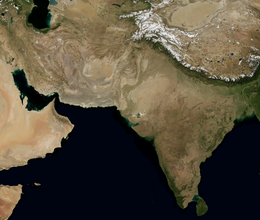Geography of Pakistan
 |
|
| Continent | Asia |
|---|---|
| Region | South Asia ; Subcontinent |
| Coordinates | 30°00'N 70°00'E |
| Area | Ranked 36th |
| • Total | 881,913 km2 (340,509 sq mi) |
| • Land | 96.9% |
| • Water | 3.1% |
| Coastline | 1,046 km (650 mi) |
| Borders | Total: 6,774 km (4,209.2 mi) Afghanistan: 2,252 km (1,399.3 mi) China: 585 km (363.5 mi) India: 2,912 km (1,809.4 mi) Line of Control: 740 km (459.8 mi) Iran: 909 km (564.8 mi) |
| Highest point |
K2 8,616.3 m (28,269 ft) |
| Lowest point |
Arabian Sea 0 m (0.0 ft) |
| Longest river | Indus River |
| Largest lake | Manchhar Lake |
The geography of Pakistan (Urdu: جغرافیۂ پاکِستان) is a profound blend of landscapes varying from plains to deserts, forests, hills, and plateaus ranging from the coastal areas of the Arabian Sea in the south to the mountains of the Karakoram range in the north. Pakistan geologically overlaps both with the Indian and the Eurasian tectonic plates where its Sindh and Punjab provinces lie on the north-western corner of the Indian plate while Balochistan and most of the Khyber Pakhtunkhwa lie within the Eurasian plate which mainly comprises the Iranian Plateau. Gilgit-Baltistan and Azad Kashmir lie along the edge of the Indian plate and hence are prone to violent earthquakes where the two tectonic plates collide.
Pakistan is bordered by India to the east, Afghanistan to the west and Iran to the southwest while China borders the country in the northeast. The nation is geopolitically placed within some of the most controversial regional boundaries which share disputes and have many-a-times escalated military tensions between the nations, e.g., that of Kashmir with India and the Durand Line with Afghanistan. Its western borders include the Khyber Pass and Bolan Pass that have served as traditional migration routes between Central Eurasia and South Asia.
...
Wikipedia
